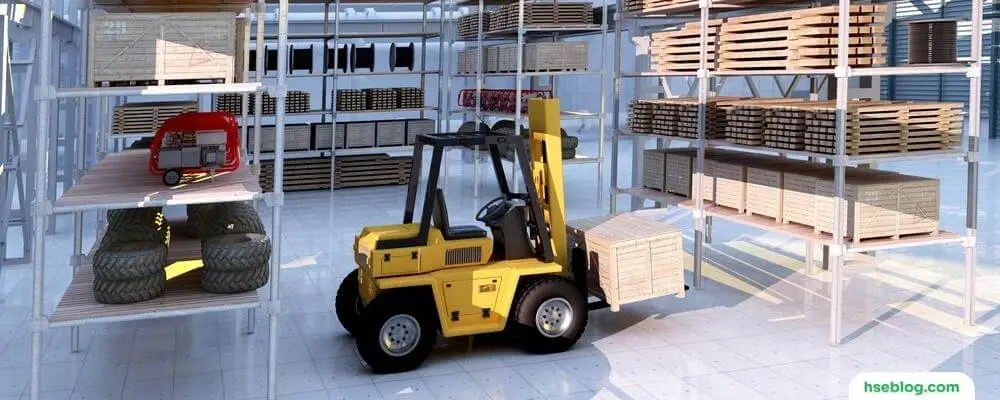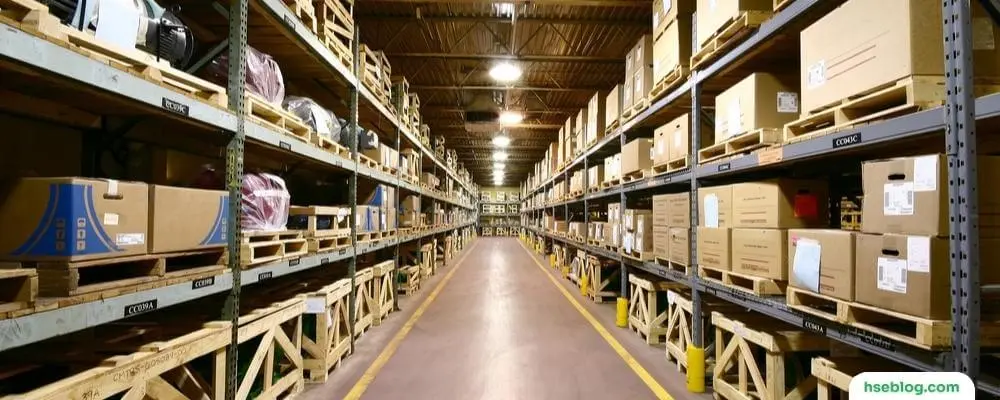Proper storage of materials is essential for maintaining a safe, organized, and efficient workspace in any factory or industrial setting. Whether storing materials for production purposes or maintaining an inventory, having appropriate storage solutions in place is crucial. Not only does this protect the materials from damage, but it also ensures easy accessibility and minimizes the risk of accidents or contamination.
This blog post explores the general requirements for storing materials in the workplace. We will discuss various storage solutions suitable for different types of materials and available space considerations. Additionally, we will highlight important aspects such as safety precautions, labelling, and proper handling methods to ensure a well-maintained storage system.
By understanding and implementing these requirements, businesses can establish an environment that promotes productivity, streamlines operations, and safeguards the integrity of their materials. Whether you work in manufacturing, warehousing, or any industry that deals with storing materials, this guide will provide valuable insights to optimize your storage practices and contribute to the overall success of your business.
Storage Of Materials In The Workplace
One of the most important aspects of running a business is storage. Whether you are storing materials for production or inventory, it is crucial that these items are stored properly. Not only does this ensure that they are protected from damage, but it also helps to keep your workplace organized and efficient.
Many different types of storage solutions are available, and the best option for your business will depend on the materials you need to store. For example, if you are storing large items that are not fragile, then you can use racks or shelves. However, if you are storing smaller items or delicate items, you may need to use boxes or bins. It is also important to consider the amount of space you have available for storage. If you have a large workplace, you may need to invest in larger storage solutions, such as pallet racks. However, if you have a smaller workplace, you can get it by using smaller storage solutions such as wire shelving.

No matter what type of business you run, it is important to have proper storage solutions in place. This will help to keep your workplace organized and efficient, and it will also protect your materials from damage. If you are unsure what storage solution is best for your business, consult a professional. They will be able to assess your needs and recommend the best solution for your business.
There are a few things to remember when storing materials in the workplace. First, you need to make sure that the materials are stored in a safe and secure location. This means they should be away from areas where they could be damaged or contaminated. Second, you need to ensure that the materials are easily accessible. This means that they should be stored in an area that is easy to reach and you can get to them quickly if needed. Finally, you need to make sure that the materials are properly labelled. This will help you and others know how to use the materials properly.
Workplaces can easily become very untidy if housekeeping is not managed. Spoil heaps at excavations, piles of new materials, debris, and waste can all accumulate very quickly. This can:
- Hinder or prevent the safe movement of pedestrians and vehicles around the workplace.
- Block light.
- Block access to essential services, such as fire equipment.
In some instances, stacks and piles of materials can present an immediate danger of collapse. Stacked materials, in particular, can topple over if they are not stacked correctly.
Good housekeeping starts with good design and layout of the workplace; sufficient space must be allocated for storing materials at the planning stage. In particular:
- Storage areas should be clearly defined.
- Separate areas should be used for different items (for ease of identification).
- Certain materials and substances should be segregated during storage; alternatively, purpose-built secure storage (e.g. gas-bottle cages) may be required.
- Areas should be kept clean and tidy and should be routinely inspected.
- Appropriate warning signs should be displayed where necessary (e.g. where flammable materials are stored).
- Storage areas should not be used for work activities.
Stacking materials is an efficient way to use space. When stacking:
- Each stack should be for one material only (not mixed).
- A maximum stack height must be set (depending on the material’s strength and stability).
- Stacks should be vertical (not leaning).
- Pallets should be used to keep materials off the ground.
- Sufficient space must be allowed between stacks for safe movement.
- Stacks must be protected from being struck by vehicles.

Requirements To Consider When It Comes To Storing Materials
The storage of materials in the workplace is important to maintaining a safe and organized work environment. Here are some general requirements to consider when it comes to storing materials:
- Compatibility: Ensure materials are stored to prevent compatibility issues and potential reactions between different substances. Store hazardous materials separately and in accordance with safety guidelines and regulations.
- Proper labelling: All materials should be properly labelled to identify their contents. Labels should include the material’s name, associated hazards, and handling instructions. This helps employees easily identify and handle materials appropriately.
- Segregation: Materials should be stored to prevent cross-contamination or mixing of incompatible substances. Separate incompatible materials to avoid potential chemical reactions or hazards. Refer to safety data sheets (SDS) or other relevant references to determine compatibility and segregation requirements.
- Accessibility: Stored materials should be easily accessible for employees to retrieve and handle without undue effort or risk. Proper storage equipment like shelving, cabinets, or pallet racks can be used to organize materials and ensure easy access. Heavier or bulkier items should be stored at waist height or lower to minimize the risk of injury during retrieval.
- Ventilation: Consider the ventilation requirements for certain materials, especially if they release fumes or gases or have specific temperature requirements. Ensure that the storage area provides adequate ventilation to prevent the buildup of potentially harmful substances or create an unfavourable environment.
- Fire safety: Implement fire safety measures when storing materials. Follow applicable regulations and guidelines for fire prevention, including keeping flammable materials away from ignition sources, using appropriate fire suppression systems, and maintaining clear pathways for emergency egress.
- Housekeeping: Regularly maintain and inspect the storage area to ensure cleanliness, organization, and proper condition of storage equipment. Clear any spills, debris, or obstructions promptly to prevent accidents or deterioration of stored materials.
- Security: Protect stored materials from unauthorized access, theft, or tampering. Depending on the nature of the materials, you may need to implement security measures such as locks, restricted access, or surveillance systems.
- Training and information: Ensure that employees are trained on proper material storage procedures and aware of any specific hazards associated with the materials they handle. Access relevant safety data sheets (SDS) or other necessary documentation to educate employees about stored materials’ properties and handling requirements.
- Regular audits and reviews: Periodically review your material storage practices to assess compliance with regulations, identify areas for improvement, and update procedures as needed. Conduct regular audits to ensure proper storage, labelling, and organization of materials.
It’s important to note that specific requirements for material storage can vary depending on the industry, country, and the types of materials being stored. Always consult relevant safety regulations, standards, and guidelines specific to your workplace and materials to ensure employees’ compliance and safety.
Materials Handling Methods
Consider these important steps to ensure safety when handling materials:
- Perform a thorough inspection of the materials for potential hazards like slivers, nails, or other objects that might be sticking out or for rough or slippery surfaces and sharp or jagged edges or burrs. These could pose risks during handling.
- Establish a solid grip on the object you’re handling. A good hold reduces the chances of accidental drops that could lead to injury or material damage.
- Remember pinch points when handling objects, particularly when placing them down. Pinch points are areas where a body part, typically a finger or hand, can get caught between objects or surfaces.
- When dealing with longer objects such as lumber or pipes, keep your hands clear of the ends to prevent them from getting pinched.
- Before handling or storing any object, clean off any substances that might make it slippery. This could include grease, water, or dirt. Handling clean objects reduces the risk of slips that could lead to injury.
- Ensure your hands are clean and free from substances like oil or grease that might make it harder to grip objects.
- Use equipment like hand pallets or hand trucks to move heavy objects. These tools can help prevent strain injuries and make the job easier.
- Limit your lifting to weights that you can handle safely. Generally, avoid lifting or carrying items that weigh more than 50 pounds without assistance. Overextending yourself can lead to injuries such as muscle strains or more severe damage.

Personal Protective Equipment
Incorporating PPE into your work routine is crucial for maintaining safety when handling materials. Here are some key guidelines:
- Use handles and holders when lifting loads. This equipment can help prevent accidents, such as pinching or smashing fingers, during lifting.
- Consider wearing steel-toed safety shoes or boots if the objects you’re moving are heavy or cumbersome. This type of footwear can protect your feet from injuries if you accidentally drop a load or slip while carrying it.
- In most circumstances, you should wear gloves or other hand protection to safeguard your hands from potential injuries during handling.
- Eye protection and sturdy gloves are necessary when opening a wire-bound box or bale. This can prevent the ends of the wire from snapping loose and striking you. Similarly, take the same precautions when handling wire, strapping, or cable coils.
- For cutting a wire or similar materials, use cutters that secure the ends during cutting. This can prevent the cut ends from springing out and causing injury.
- Following specific guidelines for handling hazardous substances is important when handling dusty or toxic materials. For instance, the University of North Carolina at Chapel Hill’s Environmental Health and Safety (UNC-CH EHS) website provides guidelines under its Environmental Affairs section.
In summary, PPE is a vital part of safe material handling. These guidelines help ensure you protect yourself effectively while performing your duties in an industrial or manufacturing setting.
Lifting and Carrying
Before employees perform heavy and/or frequent lifting, ensure they are physically suited for the job. If a load is thought to be more than one employee can handle, the employee should obtain assistance or use a lifting aid to perform the operation in a safe manner.
Proper Way to Lift
Here are six steps to safe lifting:
- Keep feet parted – one alongside and one behind the object
- Keep back straight and nearly vertical. Bend at the knees instead of the waist
- Tuck in your chin
- Grip the object with the whole hand
- Tuck in elbows and arms
- Keep body weight directly over feet
When bulky objects are to be handled or when objects are to be carried on the shoulder, employees shall be trained in these techniques for special situations.
Handling Barrels and Drums
When moving barrels and drums, they should be moved by using a dolly or other mechanical devices.
If two employees are assigned to up-end a full drum, they should use the following procedures:
- Stand on opposite sides of the drum and face each other;
- Grasp both chimes (rolled edges at both ends of the barrel) near their high points, lift one end and press down on the other;
- As the drum is up-ended and brought to balance on the bottom chime, release the grip on the bottom chime and straighten the drum.
When two employees are to overturn a full drum, they should use the following procedure:
- Make sure they have enough room. Cramped quarters can result in badly injured hands.
- Both stand near each other, facing the drum. They grip the closest point of the top chime with both hands. Resting their palms against the side of the drum, they push until the drum balances on the lower chime.
- They step forward a short distance, and each employee releases one hand from the top chime to grip the bottom chime. They ease the drum down horizontally until it rests solidly on its side.
To roll a barrel or drum, an employee should push against the sides with his/her hands. To change the direction of the roll, he/she should grip the chime, not kick the drum with his/her feet.
To lower a drum or barrel down a skid, turn it and slide it end-wise. Do not roll it. To raise a drum or barrel up a skid, two employees stand on opposite sides of the skid (outside the rails, not inside, and not below the object being raised). They roll the object up the incline. Handling drums and barrels can be hazardous, even with utmost care. Special handling equipment and tools must be available to make the job safer and easier.

Handling Cylindrical Objects
Moving and storing pipes, bars, tubes, and other cylindrical objects present unique challenges due to their shape and size. In addition to using the appropriate lifting and carrying methods mentioned earlier, follow these guidelines when dealing with cylindrical objects:
- Use pipe-handling equipment such as pipe hooks and tongs whenever possible.
- Never stand a cylindrical object on its end, as it can easily tip and roll.
- Never store cylindrical objects on a slope. If necessary, use chocks or other methods to prevent them from rolling.
- When stacking cylindrical materials, ensure they are secure and do not exceed a safe height.
- Chemicals and Hazardous Materials Storage
Storing chemicals and other hazardous materials requires strict regulations and procedures to prevent accidents and contamination. These include:
- Store chemicals according to their compatibility groups. Incompatible chemicals should be stored separately to prevent reactions.
- Keep chemicals in original containers with labels. If chemicals are transferred to secondary containers, these containers must also be appropriately labelled.
- Avoid storing chemicals on high shelves or in high cabinets. A fall could lead to a dangerous spill.
- Flammable chemicals should be stored in approved flammable storage cabinets.
- Corrosive chemicals should be stored below eye level, and acids and bases should be separated.
- Make sure ventilation is appropriate for the chemicals you’re storing.
- Always have an updated Material Safety Data Sheet (MSDS) for every chemical you store.
Following these guidelines for storing materials can ensure a safer and more efficient workplace. Remember to regularly inspect your storage areas and train your employees on proper storage and handling methods.
Conclusion
In conclusion, properly storing materials in the workplace is essential for maintaining a safe, organized, and efficient environment. By adhering to the general requirements discussed in this blog post, such as selecting appropriate storage solutions, following safety guidelines, and implementing proper labelling, businesses can protect their materials, reduce the risk of accidents, and enhance overall productivity. Regular inspections and employee training further contribute to maintaining an effective storage system. Investing in proper material storage practices ensures a smooth workflow and prioritizes employees’ well-being and the materials’ integrity for long-term success.

